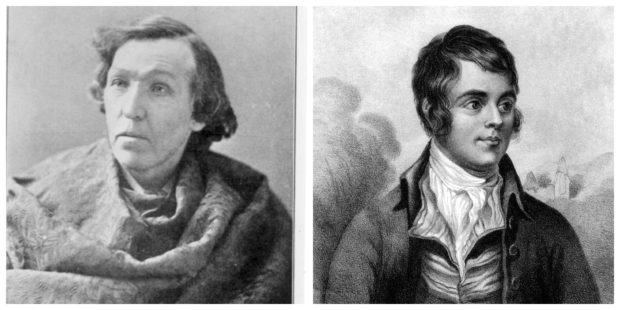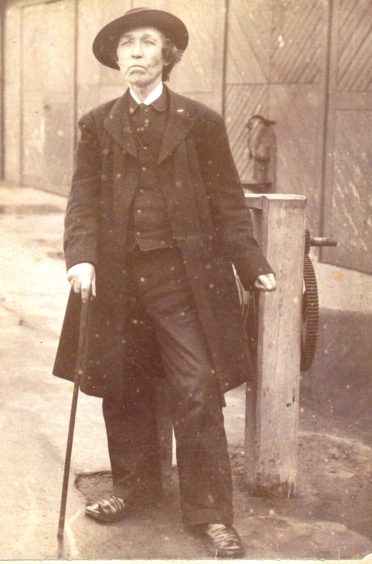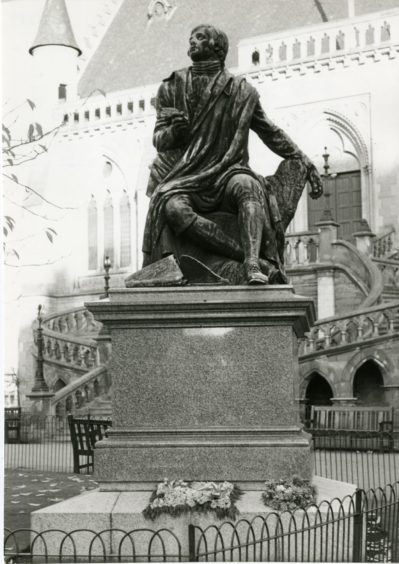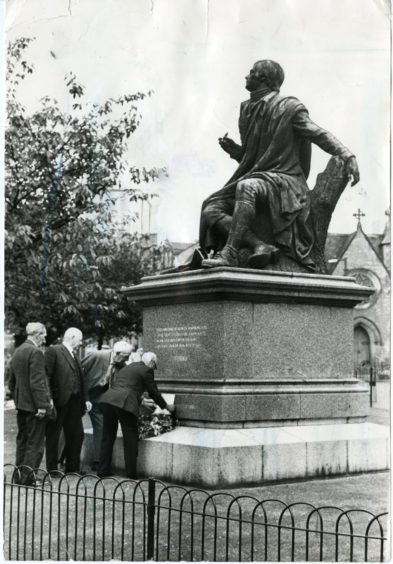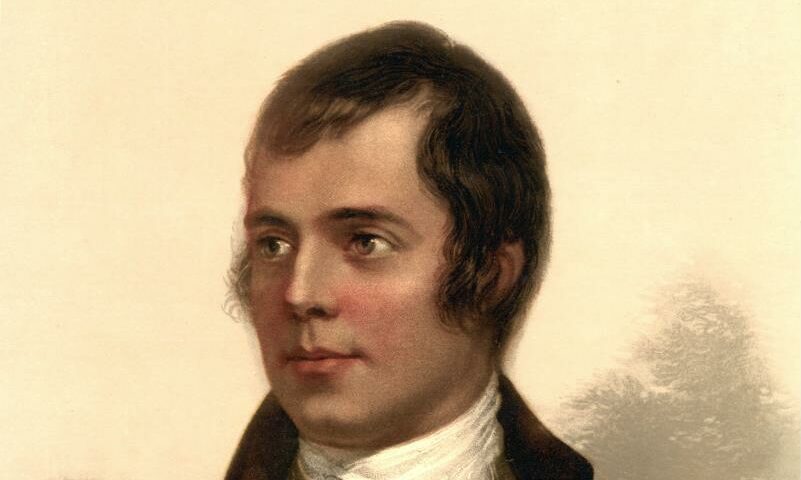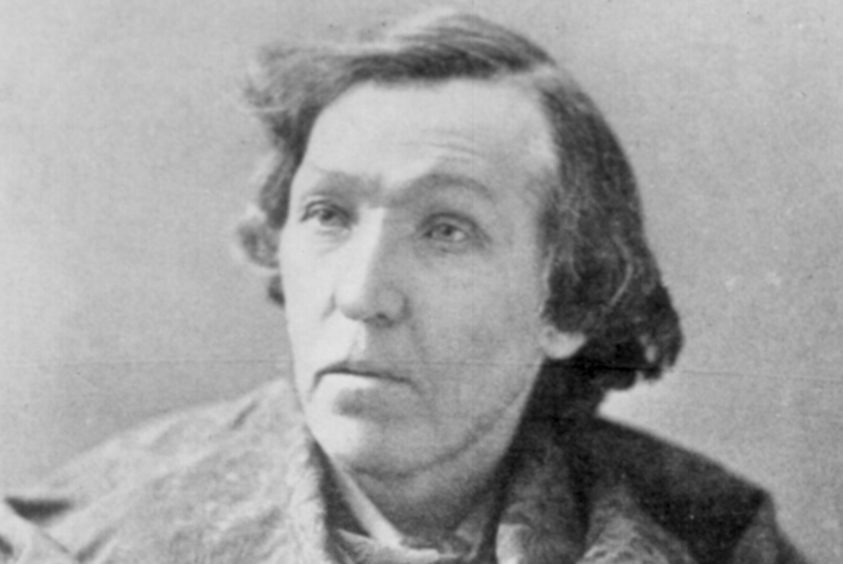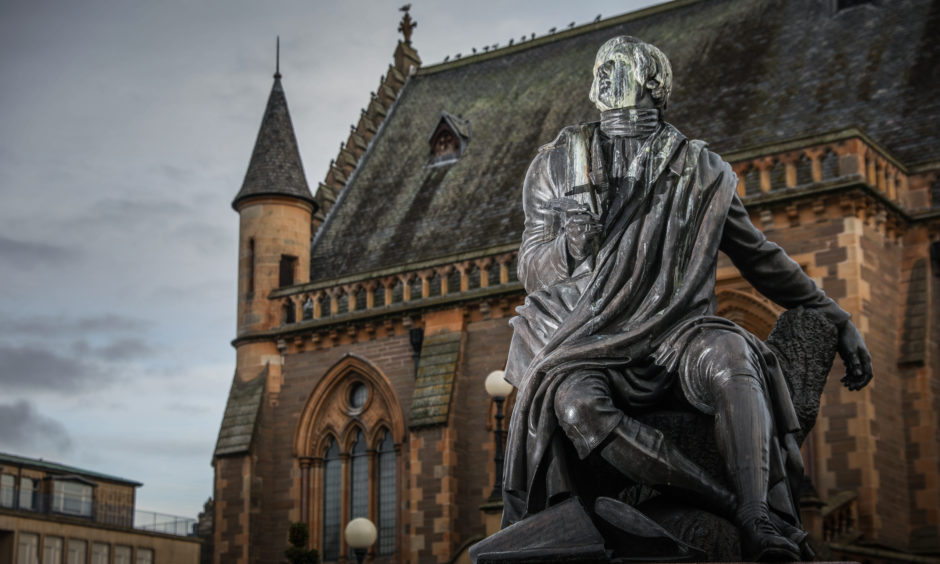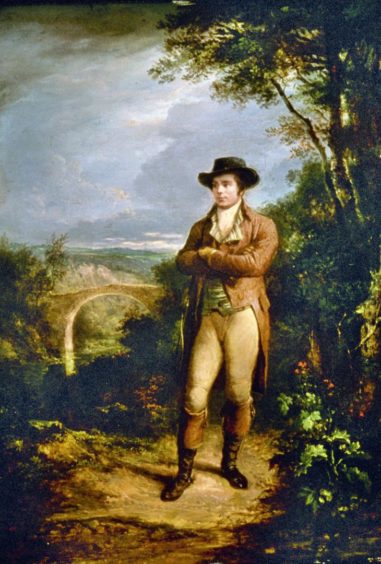The world’s worst poet William McGonagall felt the full force of the law as he attempted to upstage Scotland’s National Bard during a momentous day in Dundee’s history.
The Poet Laureate of Paton’s Lane expected to play a part in the festivities for his fellow bard when up to 100,000 people took to the streets 140 years ago for the unveiling of a commemorative statue to Robert Burns.
Designed by Scotland’s then leading renowned sculptor Sir John Steell, the bronze statue mounted on a pedestal of Peterhead granite in Albert Square, outside McManus Galleries, was inspired by the opening verse of the poem ‘To Mary in Heaven’.
Forcibly removed
McGonagall intended to deliver a newly-penned tribute to the statue on the platform at the unveiling but was refused a place and instead had to be content to march alongside some representatives of his former craft – the Lochee Union Weaver Lodge.
When he made a further attempt to get on to the platform he was forcibly removed by the police and four stanzas are all that survive of the poem which was spurned by the city fathers of Dundee.
Local author and historian Norman Watson said: “William McGonagall had already composed a blisteringly awful tribute to Burns back in September 1877.
“Immortal Robert Burns of Ayr duly extolled Scotland’s Bard over a handful of versus and began with the familiar couplet, ‘Immortal Robert Burns of Ayr/There’s but few poets can with you compare’.
“That came in the same week as his intriguing composition The Testing Day of the Bridge of the Tay. Famed today for his Tay Bridge trilogy – his Railway Bridge of the Silvery Tay (1877), the Tay Bridge Disaster (1880) and the Address to the New Tay Bridge (1887), it is evident that McGonagall celebrated the Tay crossing with a fourth poem, one that would have described in verse the 30,000 citizens who watched the contractors’ ‘donkey’ engine Mongrel make the first pass over the newly-laid rails in September 1877, and the grand fireworks display which lit up his beloved Magdalen Green.
“October 1880 brought another thudding blow to McGonagall’s reputation when he was unceremoniously refused a place on the platform at the unveiling of a statue to Robert Burns.
“The £1,000 statue had been the talk of the town for many months and the positioning of the large bronze sculpture in Meadowside, close to the Albert Institute, was eagerly awaited and drew a huge crowd on the day.
“Dundee’s own Bard intended to appear at the ceremony to deliver a public recitation of his newly-penned tribute to the statue.
“The authorities imagined public disorder would result, perhaps ruining the ceremony and making the town a laughing stock.
“McGonagall was therefore refused a place in the procession to the unveiling on the basis that he was not a member of a representative body.
“When he attempted to take a position on the stage he was forcibly moved on by police.”
The poet’s anger was later conveyed in a letter to a friend.
“I will ever remember the day I walked in the Burns’ procession in Highland costume with the manuscript of the Burns Statue poem in my hand, which I willingly would have read had I been permitted, but no! When I made the attempt for the third time, to get onto the platform, I was told by police to go away, just the same as if I had been a dog.”
As well as writing the only biography of William McGonagall, Dr Watson is the author of the newly-published Protest Stamps and Covers of Robert Burns 1956-1966.
He added: “A fragment of the poem survives.
“Its first three verses were included in Last Poetic Gems in 1968.
“A further verse was re-discovered in 2009.”
New York
The statue was a duplicate of one by Sir John Steell that had been unveiled in New York’s Central Park just two weeks earlier.
Special trains were run on October 16 1880 from Perth, Blairgowrie, Arbroath and Forfar and lines of flags stretched across the streets which were lined with spectators as the procession of the trades in the town winded its way from Magdalen Green to Albert Square.
The bronze statue was unveiled by Dundee MP Frank Henderson who described Burns as “a priceless and imperishable gift to Scotland” which was met by loud and prolonged cheers from the vast assemblage before the Artillery Volunteers fired a salvo.
“The first fact that strikes me in witnessing this vast assemblage and the enthusiasm which pervades it is the strong and ever tightening grasp which Burns has taken of the hearts and affections of the Scottish people,” said Mr Henderson.
“The memory of no other Scotchman – I may truly say the memory of no other man – could have evoked a sentiment of love and reverence so deep and universal as is manifest here today.
“We seek to honour the memory of Burns today on various grounds.
“As a poet he stands, if not in the very highest rank, very near the very highest.
“But as the national poet of Scotland he stands without a peer.
“It is as our national poet that we raise this statue to his memory.
“It is our humble tribute to his marvellous genius, his lofty patriotism, his unconquerable independence, his irrepressible love of liberty, his intense abhorrence of tyranny and oppression in all their forms, his boundless sympathy, not only with that which is distinctive, but with that also which is highest, purest, and noblest in the Scottish character.
“No man has read the Scottish character with a truer, keener, more loving eye.
“No one has interpreted it with such wonderful freshness, fidelity and power.
“It is because he did so that Burns stands in a relation to Scotland and Scotchmen in which the poets of no other country stand to their countrymen and the land of their birth.
“We find in Burns, the peasant born, one of the people, one who understood every phrase and aspect of humble Scottish life – who sang, and who sings still, our loves, our joys, our griefs, with a sweetness, a tenderness, and a power which find their way direct and at once to the hearts of all true Scottish men and women.
“It is because he has done so that Burns had endeared himself to every Scottish heart.”
The Burns Statue by William McGonagall
This Statue, I must confess, is magnificent to see,
And I hope will long be appreciated by the people of Dundee;
It has been beautifully made by Sir John Steell,
And I hope the pangs of hunger he will never feel.
This statue is most elegant in its design,
And I hope will defy all weathers for a very long time;
And I hope strangers from afar with admiration will stare
On this beautiful statue of thee, Immortal Bard of Ayr.
Fellow-citizens, this Statue seems most beautiful to the eye,
Which would cause Kings and Queens for such a one to sigh,
And make them feel envious while passing by
In fear of not getting such a beautiful Statue after they die.
See where he sits on the stump of that tree
His eyes tuned to heaven his Mary to see,
A scroll at his feet, a pen in his hand
Writing to his Mary in the Better Land
The Bard’s Tayside connections
Robert Burns travelled Dundee’s streets, commented favourably on the city, had family in Angus and his own father was from The Mearns.
Born in 1759, Burns grew up in poverty and his relatively short life — he died at the age of 37 — was marked with hardship and ill health.
However, his poems and songs struck a chord not only in his native land but across the world.
He was a famous figure when he took a tour of the Highlands in 1787 in the company of his friend William Nicol.
Blair Castle
The pair left from Edinburgh and travelled to Stirling, Birnam and Blair Atholl where Burns enjoyed dinner at Blair Castle with the Duke of Atholl.
It was then on to Inverness, Banff, Aberdeen and into Kincardineshire, which Burns called “the land of his fathers”, then they crossed the North Esk into Forfarshire “halting at Montrose on the 12th September”.
The Montrose of that day Burns described as “that finely situated, handsome town”.
The evening was spent with Mr James Burness, a cousin of the poet’s who was then in practice as a writer.
Leaving Montrose early in the morning, Burns, Nicol and a Mr Carnegie journeyed to Auchmithie, where they breakfasted, and then sailed along the coast to Arbroath, the poet making special note of the stately ruins of the abbey.
Resuming their journey, Burns was impressed by the fertile country between Arbroath and Dundee and old Broughty Castle.
He stayed in Dundee for nearly two days at the house of David Jobson, a bank cashier, in Bain Square.
Bidding goodbye to his Dundee friends, Burns and his companions proceeded “through the rich harvests and fine hedgerows of the Carse of Gowrie” to Perth.
After he was back in Edinburgh he penned a letter to his younger brother Gilbert.
He wrote: “Arrived here safe yesterday evening after a tour of 22 days and travelling near 600 miles.
“I returned by the coast, through Nairn, Forres, and so on, to Aberdeen, thence to Stonehive where James Burness, from Montrose, met me by appointment.
“I spent two days among our relations, and found our aunts, Jean and Isabel, still alive, and hale old women.”
In addition to this letter, Burns’ diary is full of notes describing what he saw and who he met.
Sea legs
“Thursday — Go to Montrose, that finely-situated handsome town, breakfast at Muthie and sail along that wild rocky coast and see the famous caverns, particularly the Gariepot. Land and dine at Arbroath, the stately ruins of Arbroath Abbey.”
The portion of the journey undertaken by boat was, apparently, the first time Burns had been at sea.
After alighting from the vessel at Arbroath he travelled by post chaise — a small, covered four-wheeled carriage — to Dundee.
“Come to Dundee through a fertile country. Dundee is a low-lying, but pleasant town with the old steeple and Broughty Castle, a finely situated ruin, jutting into the Tay.”
